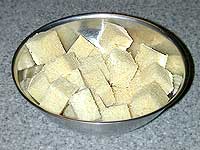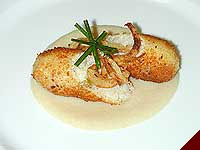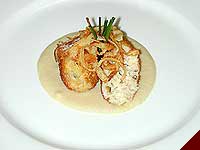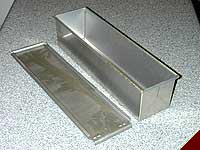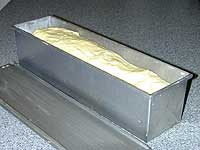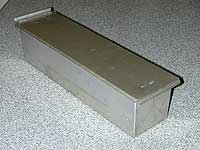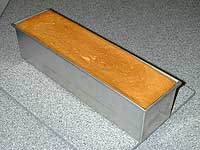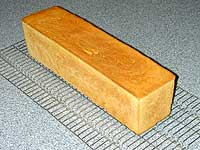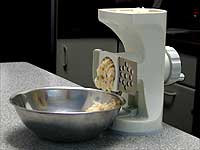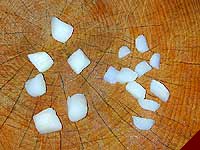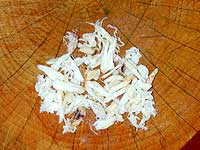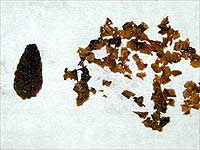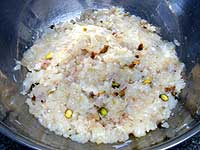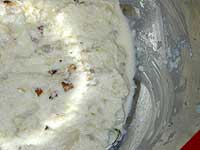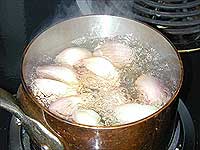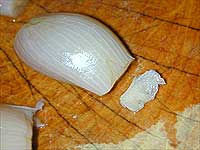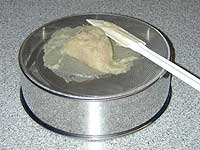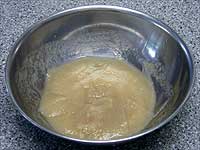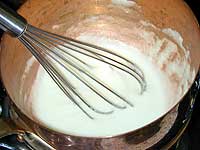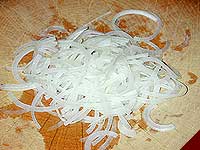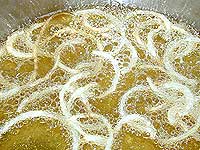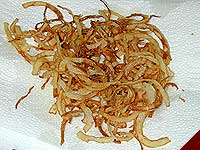
I’ve been eating sausages of all types for as long as I can remember. Whether as luncheon meats between slices of bread or main courses during winter dinners, my German mother made sure that sausages were a part of my life. When I grew up, I didn’t reject my upbringing. On the contrary, I embraced it by eating sausages from many countries, including France, Germany, Switzerland, Italy, Sweden, Denmark, Spain, and even China. (But, I still haven’t acquired the taste for British bangers!)
I fondly remember one meal in particular. When I was 15, I was traveling in Europe as part of a troop of Boy Scouts. One day, when I was in Luzern, Switzerland, my older brother, who was serving in the U.S. Army in Southern Germany at the time, came to visit me. We jumped on the first milk train leaving the station and got off about an hour later in a village called Goshen. It was about lunch time so we climbed a small hill to a restaurant. There we sat outside, in the garden, in the shadow of the Alps eating Swiss-style bratwurst covered with a brown sauce and accompanied by fried potatoes. We washed this down with a Swiss pilsner while a chicken pecked in the gravel near our feet. It was a meal that was over much too quickly, and one that I still remember well, 37 years later.
Since then, I’ve even learned how to make my own sausages at home — stuffing combinations of beef, pork, chicken, veal, and duck into the former intestines of hogs or sheep. Sometimes the forcemeat is ground, sometimes it is puréed. Some sausages are served fresh and some are poached as part of the preparation. But, I’ve never learned how to make smoked sausages and I don’t have the facility for preparing dried ones.
In May, my sausage experience took a sharp turn — a turn to the sea — or should I say seafood. Now this wasn’t the first time I had been exposed to seafood sausage. Years ago, I learned how to make seafood sausage at a course at the California Culinary Academy. Unfortunately, these were barely edible at the course and not any better when I attempted them at home. I’ve seen similar recipes in various sausage cook books. It seems that each book has one token seafood sausage recipe.
The problem with seafood sausages is that usually they are dry. In meat sausage, the fat content is usually between 25 and 50%. The fat provides both flavor and mouth feel to the sausage. Eating lean sausages is usually like eating cooked, flavored cardboard. In the past, the seafood sausage I had eaten tasted like overcooked fish stuffed into a piece of hog intestine. That changed in May.
When I first tasted the cervelas de crustacés à la crème d’echalotes from Charles Barrier in Tours, I knew that I had to figure out how to prepare this dish at home. I obtained a copy of the recipe from the sous chef at Le Château d’Amondans. It looked something similar to the following.
The remainder of the recipe — the bread crumbs, the sauce, and the garnish was transmitted verbally in a couple of sentences. One problem with this recipe is that merlan, a fish similar to whiting, and langoustines, a crustacean similar to Dublin Bay prawns, are generally not available in California. Another problem with this recipe is that it produces more than 23 pounds of forcemeat — enough for 150 portions! Since my return from Amondans, I’ve spent considerable time developing a version of the recipe that can be prepared for four guests. The following is the result of my efforts.
This is not a recipe that can be thrown together at the last minute. The bread is baked three or four days in advance so it has a chance to dry. The sausages, except for the final preparation for service, are prepared one day in advance. The shallots for the sauce may be prepared a day in advance to simplify the work required at the last minute. Because of all the preliminary work required, the recipe has been broken into a number of parts which can be reached by clicking on the appropriate links.
The recipe may appear to be a lot of work for four or five bites of sausage served during an appetizer (entrée) course, but your guests will appreciate the effort. You’ll like it, too.
Traditionally, cervelas in France were sausages made from pig’s brains, or cervelle — thus the name. Nowadays, it is not uncommon to find versions of cervelas made from other parts of the pig. The term cervelas in this recipe refers to the shape of the sausage — not the forcemeat. In fact, the forcemeat is really a seafood mousseline shaped like a sausage.
75 grams (about 2" x 4" x 4")
Trim the crust from the
pain de mie and process the bread in a food processor until uniform crumbs are produced. The bread needs to be dry, but not rock hard. I usually will cut the bread into 2-1/2 cm (1") cubes before processing. If the bread is too soft, I let it sit out on the counter for a few hours before I make the crumbs.

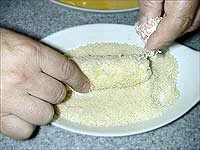

Place the crumbs in a shallow dish and the beaten egg in another. Carefully unwrap the chilled sausages and dry, if necessary, on absorbent paper. Dip each sausage, in order, in the beaten egg. Allow the excess to drain off, and then generously coat each sausage with bread crumbs. Shake off any excess crumbs. Set the sausages aside on a plate until the oil is ready. The sausage can be coated an hour or so in advance and kept in the refrigerator until needed.
Fill a large, non-stick sauté pan with oil to a depth of 3 mm (1/8") deep and place the pan over medium heat. Gently sauté sausages until golden on all sides. Drain each sausage on absorbent paper. They may be keep warm in a 75 °C (170 °F, thermostat 2-3) oven for up to an hour. The serving plates can be warmed in the same oven.
Place 2 tablespoons of
sauce in the center of each serving plate and spread it into a 10 cm (4") circle. Cut each sausage into two, with a serrated knife, on the diagonal. Arrange two sausage halves on top of sauce. Garnish each pair with a few fried
onions and four or five pieces of
chive.
No matter how you arrange the sausages, be sure to serve them immediately. This recipe will produce 4 or 5 servings.


325 milliliters
whole milk
33 grams (2-1/3 tablespoons)
sugar
15 grams (1-1/3 tablespoons)
dry yeast
750 to 825 grams (26 to 29 ounces)
flour
24 grams (1-1/2 tablespoons)
salt
75 grams (about 6 tablespoons)
very soft butter
Place the milk and the water in a small sauce pan. Gently heat the liquid to 38 to 43 °C (100 to 110 °F). Remove the sauce pan from the heat. Add the sugar to the liquid and stir to dissolve.
Transfer the liquid to a small mixing bowl and sprinkle the yeast over the surface (left). Let the mixture stand for 10 minutes to proof (right).
Combine 750 grams (26 ounces) of the flour and the salt in the bowl of a stand mixer fitted with a dough hook. Using low speed, mix the dry ingredients briefly. Make a well in the center of the flour and add the yeast mixture. Using low speed, mix until the dry ingredients are incorporated. Add the butter and continue mixing until blended. Increase the speed slightly and knead the dough for 10 minutes. Incorporate the additional flour if the dough seems to wet. Form the dough, by hand, into a ball and set it in a buttered bowl. Cover the bowl with buttered plastic wrap and let the dough rise until it is doubled in volume, about an hour.
Butter a covered, 10 cm x 10 cm x 40 cm (4" x 4" x 16") loaf pan.
Punch down the dough and form it into a long loaf shape. Place the dough in the loaf pan and press it into the corners. Cover the pan with plastic wrap.
Allow the dough to rise again until the top of the dough just reaches the top of the loaf pan. In the meantime, preheat the oven to 205 °C (400 °F, thermostat 7).
Remove the plastic wrap covering the bread pan and slide the metal cover into place. Bake the bread for 45 minutes.
Uncover the bread pan and unmold the bread onto a rack. Allow the bread to cool completely before wrapping.
This recipe produces an even-textured bread that is mostly crumb with very little crust. (In French, mie means crumb — hence pain de mie.) Only a 5 cm (2") long piece of bread is required to make the crumbs for coating the sausages. The remainder of the loaf can be used for making excellent croutons, great bread pudding, or toast to accompany foie gras. This recipe was adapted from one on page 55 of Paris Boulangerie-Pâtisserie by Linda Dannenberg (1994).


200 grams (7 ounces)
ground cod (purchase 0.65 to 0.75 pounds)
35 grams (1-1/4 ounces)
shrimp meat (purchase 0.12 pound, about 4 medium shrimp)
35 grams (1-1/4 ounces)
bay or sea scallops (purchase 0.1 pounds)
17 grams (5/8 ounce)
crab meat (purchase 0.05 pounds)
7 grams (1/4 ounce)
pistachio nut meat
2 grams (1/16 ounce)
black truffle (or use 3 grams morel mushrooms)
3 grams (about 1/2 teaspoon)
fine salt
1 (about 20 grams) large
egg yolk
75 grams (2-5/8 ounces)
heavy cream
6 grams (about 2 teaspoons)
cornstarch
Place the cod in a freezer and cool until almost frozen. Cut the fish into pieces appropriate for the grinder being used, and grind the cod through the finest blade. Refrigerate the ground cod while preparing the remaining seafood ingredients.
Peel and devein the shrimp. Cut the shrimp into 6 mm (1/4") pieces, or smaller. Refrigerate the shrimp pieces until needed. (From left to right, a shrimp as purchased, a peeled shrimp, a deveined shrimp, and the shrimp cut into pieces.)
Discard any soft pieces of scallop. Cut the scallops into 6 mm (1/4"), or smaller pieces. Refrigerate the scallop pieces until needed. (Shown at left are bay scallops as purchased, on the right are the cut scallops.)
Clean the crab meat and shred into small pieces. Refrigerate the crab meat until needed.
Cut each pistachio into 3 or 4 pieces. Set aside until needed. (Shown at left are whole pistachio meats, on the right are the cut nut meats.)
Very finely dice the truffle (or the mushroom). Set aside until needed. (A reconstituted dried morel is shown to the right.)
Using a rubber spatula, thoroughly combine the seafood, nut meat, truffle, and salt. In a separate bowl, using a whisk, stir (not beat) the cream with the cornstarch. The forcemeat expands greatly during cooking. It is important not to beat air into the mixture which would cause the forcemeat to expand even more.
Add the egg yolk to the cream mixture and combine thoroughly. Fold three-fourths of the cream mixture into the seafood and combine thoroughly. Continue adding the cream mixture in small amounts until a small amount of cream separates at the edge of the bowl. Chill the mixture thoroughly before proceeding.
Lay a large piece of plastic wrap on a flat surface. Spoon the seafood mixture down the center of the plastic. Using a rubber spatula, shape the mixture into a 5 cm (2") wide by 1 cm (3/8") high linear mound.
Fold one of the long edges of the plastic wrap over to the opposing edge and press to seal. Using the spatula, or a finger, press the plastic until the seafood is gathered into one long sausage shape.
Roll the filled portion of the plastic over onto the unfilled portion to produce a cylindrical shape. Run a finger up and down the plastic to even out the filling. The filling should not be too tight. Natural, medium-size hog can be substituted for the plastic wrap method of encasing the sausage. When natural casing is used, the sausage shape will be curved rather than straight. Also, it is very important not to overfill the casing since it will not expand during cooking as much as the plastic wrap, and can burst during steaming.
Lay 6 pieces of cotton string under the seafood mixture at 10 cm (4") intervals. Tie off each section very tightly with a square knot. The square knot allows the string to sit perpendicular to the sausage. Other types of knots can leave a dimple in the end of the individual sausages.
At each end, tie off a 2 cm (1") piece of sausage. Then tie off a 6 mm (1/4") section. These two small “sausages” will prevent the strings at the end of the outer sausages from slipping under the pressure of the forcemeat expanding during cooking. The two knots to the right are square knots.
Set up a steamer filled with simmering water (95 °C, 200 °F). Place the “string” of seafood sausages in the steamer. Using the tip of a sharp, round skewer, poke 3 or 4 small holes in each sausage. Steam the sausages for 25 minutes or until the internal temperature reaches 85 °C (185 °F)
Place the cooling sausages on semicircular forms, such as those used to form icing flowers, to prevent the sausages from forming flat bottoms. Thoroughly cool the sausages in a refrigerator to 4 °C (40 °F) for at least 12 hours. The sausages should be prepared through this step one day in advance.
When cold and firm, carefully cut the sausages apart by cutting on each side of the knots. Carefully unwrap each sausage. Wipe off any cream that has formed on the surface with a piece of absorbent paper. Set the finished sausages aside until needed.

©2000, 2014 Peter Hertzmann. All rights reserved.

